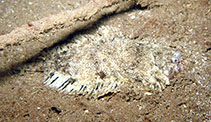| Family: |
Soleidae (Soles) |
| Max. size: |
20 cm SL (male/unsexed) |
| Environment: |
demersal; marine; depth range 10 - 250 m |
| Distribution: |
Eastern Atlantic: Portugal to Ghana. |
| Diagnosis: |
Dorsal soft rays (total): 50-58. This species is distingusihed by the following characters: body oval, stocky, laterally compressed; greatest depth in anterior one-third with moderate anterior and more gradual posterior taper beyond this point; head relatively large, broadly rounded anteriorly; short snout rounded; eyes separated by small, concave, interorbital space; mouth symphysis reaching vertical through middle of lower eye; ocular-side anterior nostril tubular, reaching beyond anterior margin of lower eye; blind-side anterior nostril tubular; D 50-58, fin's origin anterior to vertical through anterior margin of eyes; A 40-45; dorsal and anal fins are not connected to caudal peduncle; caudal peduncle very distinct; pectoral-fin rays 5-6 on ocular side, absent on blind side; scales trapezoid, very rough; pored lateral line scales 52-54, supratemporal branch of lateral line not distinct. Colour: ocular side is greyish or reddish brown with darker spots or irregular bands, the dorsal and anal fins with alternating series of 1 or 2 lightly pigmented and 4 to 6 darkly pigmented fin rays, the pectoral fin darker than body colour; blind side whitish (Ref. 109259). |
| Biology: |
This demersal species is found on sand and mud bottoms on the continental shelf (10-250 m), and also occurring frequently near plant growth. Common length between 10 and 15 cm SL. Taken in by bottom trawls and shore seines. Marketed fresh in some countries, rejected in others (Ref. 109259). |
| IUCN Red List Status: |
Data deficient (DD); Date assessed: 12 July 2012 Ref. (130435)
|
| Threat to humans: |
harmless |
Source and more info: www.fishbase.org. For personal, classroom, and other internal use only. Not for publication.

